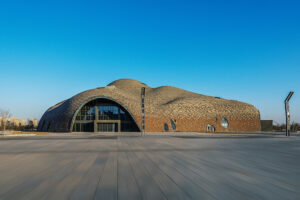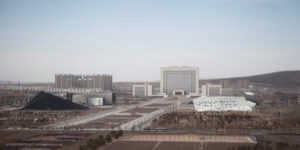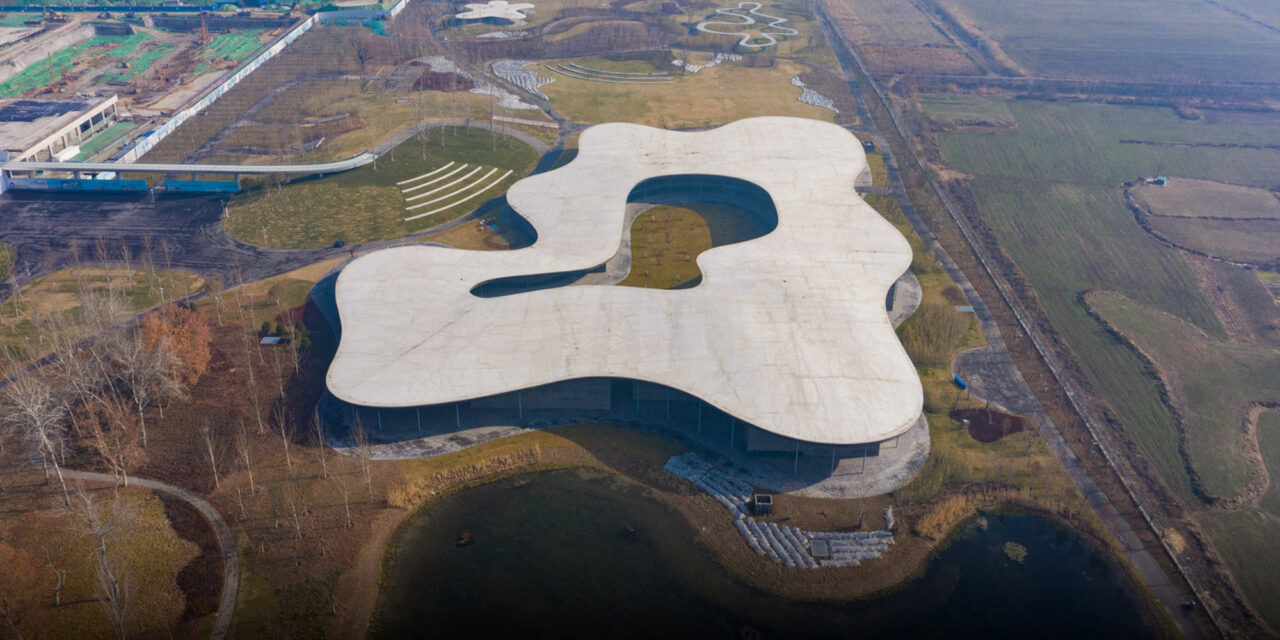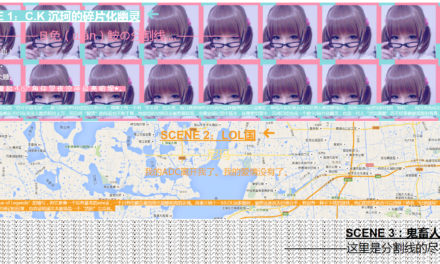Chinese cities have established thousands of new museums over the past two decades, but construction is all too often motivated by dreams of real estate riches rather than accessibility.
Even after decades of investment, China’s spending spree on public cultural buildings — everything from museums to libraries and opera houses — shows little sign of abating. This is true not just in financially stable cities with ambitions for global recognition like Shanghai, Beijing, or Shenzhen, but also in smaller, more debt- and subsidy-dependent cities in the country’s interior. To give an idea of the scale of this craze, China went from a total of roughly 300 museums nationwide in 1978 to more than 5,000 in 2018.
In contrast to most developed economies, where museums and art galleries would likely be situated near the urban center, many of these mammoth new cultural landmarks have been built in sparsely populated suburbs or newly planned urban districts. In doing so, local officials have sought to leverage these institutions to simultaneously elevate their city’s image and spur investment and real estate development along the urban periphery.
Arguably the apex of this public landmark-centric approach to urban redevelopment is the small city of Datong in the northern Shanxi province. During the socialist era, Datong was a company town dominated by the Datong Mining Bureau, one of China’s largest coal producers. At its peak, the city was responsible for 7.5% of all coal mined nationwide. By the 2000s, however, the exhaustion of coal resources and volatility of coal prices necessitated that the city reshuffle its economy.
Then, in 2008, an ambitious young official named Geng Yanbo was named mayor of Datong. Known for his impetuous approach to public decision-making, Geng championed a new plan for Datong defined by the slogan “one axis, two cities separating old and new.” In essence, Geng divided Datong in two, simultaneously restoring the old city’s Ming-era walls, temples, and other historical sites while establishing the Yudong New District to the east of the old city.
To bring his plans to life, Geng spent lavishly, inviting world-renowned architects to design urban landmarks for his new district. The Datong Library was designed by Preston Scott Cohen of Harvard University; architects from the British practice Foster + Partners contributed to the design of the Datong Art Museum; Japanese architect and recipient of the 2019 Pritzker Architecture Prize Arata Isozaki designed the Datong Grand Theatre; Australian-based firm Populous designed the Datong Sports Center; and one of China’s most well-known architects, Cui Kai, designed the Datong Museum. These towering new landmarks were meant to put Yudong on the map, literally. Their fame would attract residents and drive land sales — the proceeds from which would both pay for developing the rest of Yudong and restoring old Datong.

An exterior view of the Datong Grand Theatre, 2019. 500px/People Visual
That never happened. Geng’s wild spending didn’t produce the returns he promised, and by the time he was transferred out of the city in 2013, Datong was in an estimated 20 billion yuan ($3.1 billion) of debt. Today, his vast complex of post-modern landmarks looms over the Yudong New District’s vast central square and the area’s far more drab and austere government buildings, while progress bringing the old city back to life has stalled.
Datong was an extreme case, but far from an exception. The eastern city of Jining — another important coal and agricultural center — officially established its own new urban district in 2008. Officials touted Taibaihu District as Jining’s future, laying out grand visions of exurban aquaculture farms redeveloped into a new urban center. Internationally renowned architects were hired to design a vast cultural complex at the heart of the new district. Plans called for a Jining Library, Jining Museum, and Jining Art Museum as part of a complex of commercial buildings.
As in Datong, these landmarks have produced mixed results. Residents are divided in their attitudes toward the complex: Some see the museum as a nice “check-in” spot — a social media-friendly backdrop for photos. Others see the complex and the redevelopment plan as a whole as a misfire: After Jining moved public infrastructure like schools, museums, libraries and services out to the new area, residents of the old urban core have been forced to choose between relocating or accepting a more expensive commute.
Datong and Jining are representative of what some scholars have termed “Chinese-style city building,” in which urban expansion is pursued with explosive speed, often by relocating growth to the urban periphery where potential development profits are higher. But the specific ways China’s urban building craze has manifested — and in particular, the central role of large cultural centers like museums — is also tied to incentives within the country’s bureaucracy.
“Many of these mammoth new cultural landmarks have been built in sparsely populated suburbs or newly planned urban districts.”
— You Xudong, researcher
After the Chinese government designated the “cultural industry” as a new focus of development in 2002, the National Cultural Heritage Administration announced that the country would erect 1,000 new museums by 2015. Technically, this was nothing new: China had already proposed in the late 1950s that “every county must have its museum, every commune its exhibition hall.” But modern-day Chinese cities were better positioned to actually achieve that goal. Some 1,500 new museums had been built by 2013, meeting and exceeding the goal two years ahead of schedule.
The idea to expand cultural infrastructure was not illogical. Internationally, a successful museum can help raise a city’s profile, attract tourists, and fuel development. China’s city planners clearly hoped to replicate that domestically, albeit with some tweaks to better suit their personal and professional aims. No matter where you are in the world, public infrastructure always goes hand-in-hand with real estate development, as government-funded cultural landmarks boost the value of the surrounding land and housing. In China, however, the reliance of local governments on land sales to fund their everyday operations ensured that officials would prioritize the projects’ impact on land values over everything else. Many municipal decision-makers and real estate developers have pushed for landmark buildings to be built not in urban cores where the potential for land sales is low, but in new, largely undeveloped districts in need of residents. A side effect of this is a far greater emphasis on the architecture and appearance of these buildings over the quality of the artifacts or exhibitions they house, so much so that many new Chinese museums are more valued as backdrops for photos than for the collections they house.
On the plus side, the construction of cultural landmarks in Chinese cities is usually executed with more efficiency than in other countries, where such projects frequently run into delays and go over budget. With their broader scope of authority, local administrative heads are able to push large-scale projects through various obstacles. But even this is a double-edged sword. If a powerful city leader is subsequently reassigned, there is a chance their successors might abandon costly projects mid-development. For instance, construction on public buildings in Yudong New District came to a standstill once Geng was transferred out of the city in 2013. It wasn’t until four years later that a new administration resumed the projects.

A general view of the Yudong New District in Datong. Courtesy of You Xudong
The rising number of museums in Chinese cities — especially those with traditionally sparser access to cultural resources — should be a cause for celebration, but planners need to start seeing these facilities as engines of community development, not real estate speculation. That means focusing more on function and visitor experience when launching and designing new buildings, as well as devoting more funding to exhibitions and maintenance rather than chasing eye-catching designs.
So much of “Chinese-style city development” is predicated on the mistaken notion that, “If you build it, they will come.” But in practice, China’s practice of regularly rotating officials and the need on the part of those officials to constantly show progress and high-profile achievements to advance up the hierarchy mean that many local bureaucrats lack the patience to create and stick to a long-term operational plan for public institutions. Sustained investment and attention — not glitzy new construction projects — can turn a backwater into a livable, attractive urban area.
Translator: Katherine Tse; editors: Cai Yineng and Kilian O’Donnell; portrait artist: Zhou Zhen.
This article was originally published by Sixth Tone on November 6, 2021, and has been reposted with permission. To read the original article, click here.
This post was written by the author in their personal capacity.The opinions expressed in this article are the author’s own and do not reflect the view of The Theatre Times, their staff or collaborators.
This post was written by Xudong You.
The views expressed here belong to the author and do not necessarily reflect our views and opinions.


















